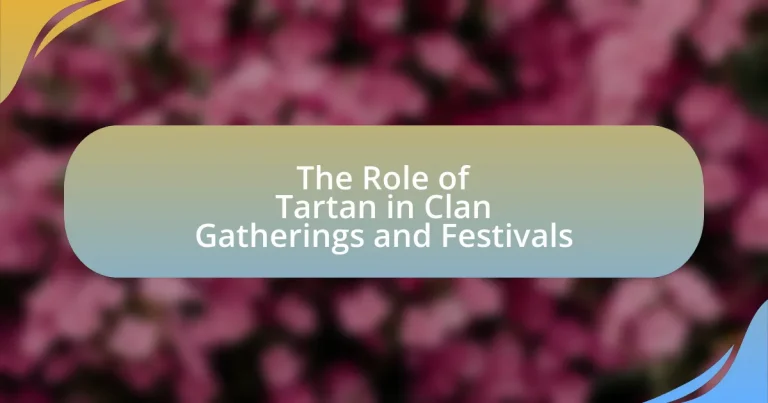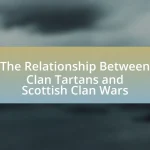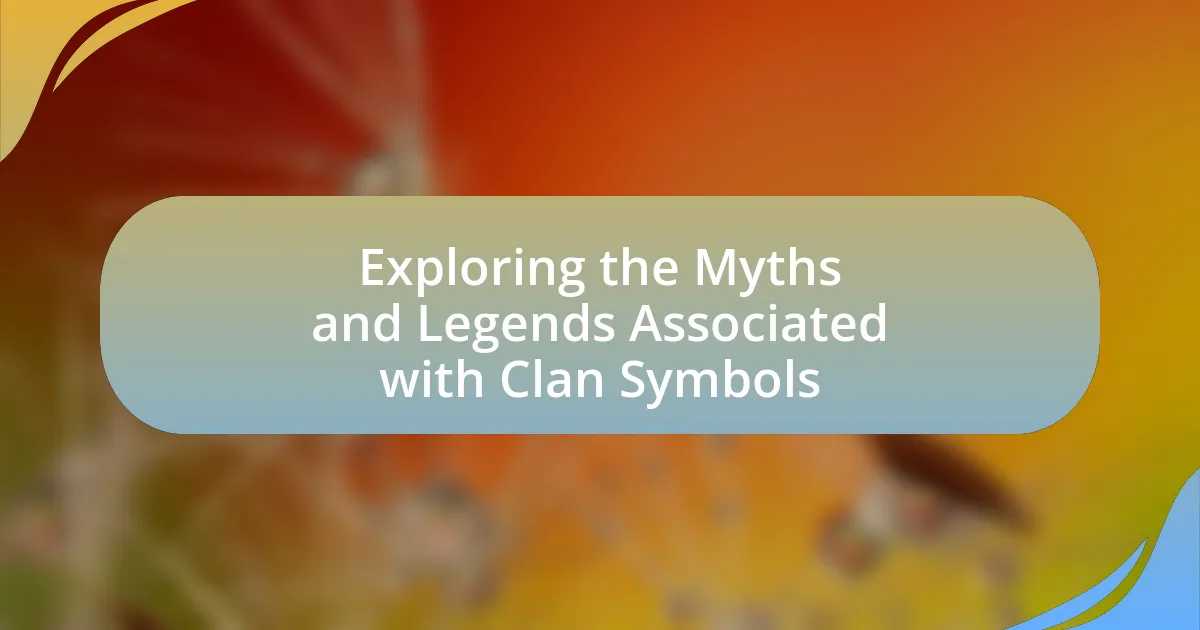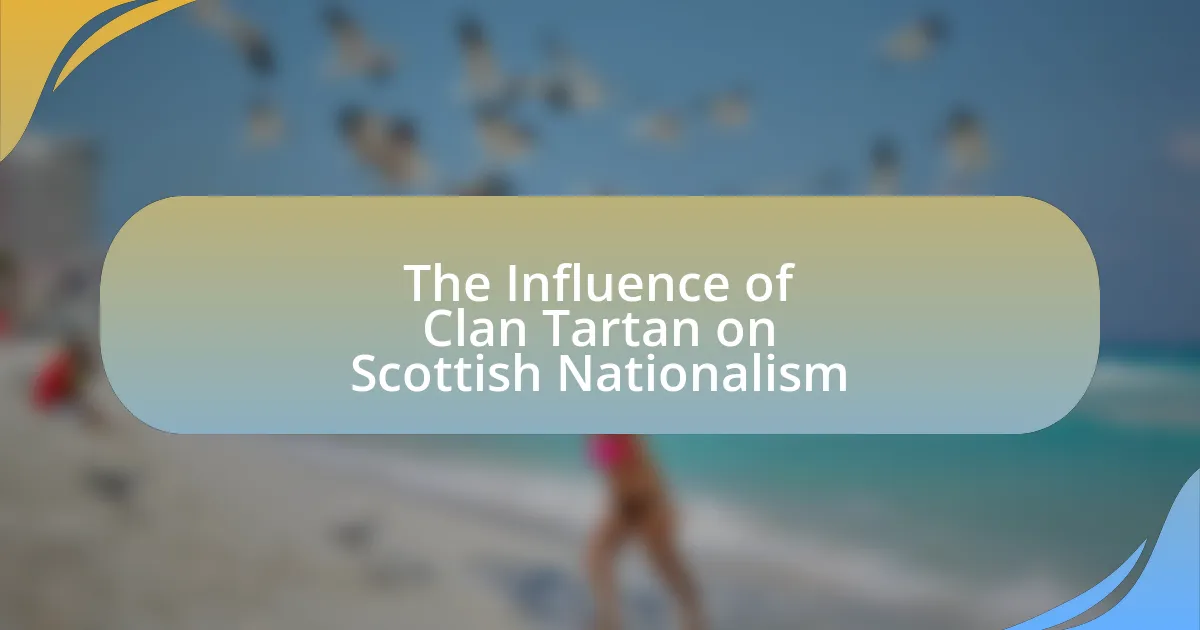Tartan is a significant cultural symbol in Scottish clan gatherings and festivals, representing clan identity, heritage, and unity. Each tartan pattern is uniquely associated with specific clans, reflecting their history and values, and fostering a sense of belonging among members. The article explores the historical evolution of tartan’s association with clans, its role in modern celebrations, and the challenges faced in preserving its authenticity. Additionally, it discusses how tartan is utilized in various activities, ceremonies, and competitions, reinforcing cultural traditions and community bonds among clan members.
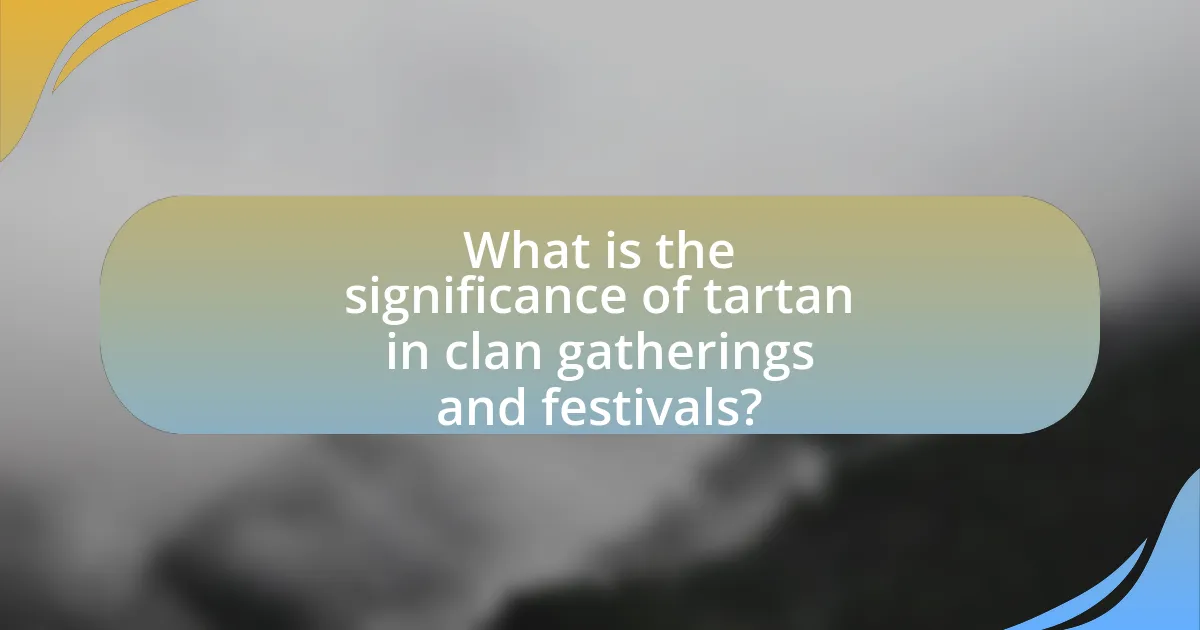
What is the significance of tartan in clan gatherings and festivals?
Tartan holds significant cultural importance in clan gatherings and festivals as it symbolizes clan identity and heritage. Each tartan pattern is associated with a specific Scottish clan, representing its history, values, and lineage. During these events, individuals wear their clan’s tartan to express pride and unity, reinforcing social bonds among members. The tradition of wearing tartan dates back centuries, with documented use in the 16th century, showcasing its deep-rooted connection to Scottish culture. This practice not only fosters a sense of belonging but also serves as a visual representation of the clan’s legacy and traditions during communal celebrations.
How did tartan become associated with Scottish clans?
Tartan became associated with Scottish clans primarily through its use as a distinctive pattern that represented specific clans and their identities. Historically, each clan developed its own unique tartan pattern, which was used in clothing and textiles, allowing members to visually identify themselves as part of a particular group. The formalization of this association occurred in the 18th century when the Scottish Act of 1746 prohibited the wearing of tartan as a means of suppressing Scottish culture, leading to a resurgence of tartan as a symbol of clan pride and identity during the subsequent Romantic movement. This cultural revival solidified tartan’s connection to Scottish clans, as it became a prominent feature in clan gatherings and festivals, reinforcing the sense of belonging and heritage among clan members.
What historical events contributed to the adoption of tartan by clans?
The adoption of tartan by clans was significantly influenced by the Jacobite uprisings of the 18th century. These uprisings, particularly the 1745 rebellion led by Charles Edward Stuart, fostered a sense of Scottish identity and unity among clans, leading to the widespread use of tartan as a symbol of allegiance and heritage. Following the defeat at the Battle of Culloden in 1746, the British government attempted to suppress Scottish culture, including the wearing of tartan, which ironically increased its significance as a symbol of resistance and pride among clans. The subsequent lifting of the ban in 1782 allowed for the revival and popularization of tartan, solidifying its role in clan gatherings and festivals as a representation of clan identity and tradition.
How does the design of tartan reflect clan identity?
The design of tartan reflects clan identity through specific patterns, colors, and motifs that are unique to each clan. Each tartan pattern is associated with a particular Scottish clan, symbolizing heritage and lineage. For example, the MacLeod tartan features distinctive yellow and black stripes, which represent the MacLeod clan’s history and values. This visual representation fosters a sense of belonging and unity among clan members during gatherings and festivals, reinforcing their shared identity and cultural pride.
Why is tartan considered a symbol of heritage during clan events?
Tartan is considered a symbol of heritage during clan events because it represents the unique identity and history of specific Scottish clans. Each tartan pattern is associated with a particular clan, reflecting its lineage, traditions, and cultural significance. Historically, tartans were used to signify clan allegiance and unity, especially during gatherings and festivals, reinforcing social bonds among members. The use of tartan in these contexts serves as a visual representation of pride in one’s ancestry and connection to the clan’s past, making it a powerful emblem of heritage.
What role does tartan play in the celebration of Scottish culture?
Tartan serves as a symbol of Scottish identity and heritage, playing a crucial role in the celebration of Scottish culture. It represents clan affiliation, with specific patterns associated with different Scottish clans, thereby fostering a sense of belonging and community during gatherings and festivals. Historically, tartan was used to signify social status and regional identity, and today it is prominently featured in traditional attire, such as kilts and sashes, worn during cultural events like Highland games and ceilidhs. The use of tartan in these contexts not only honors Scotland’s rich history but also reinforces cultural pride and continuity among Scots and those of Scottish descent worldwide.
How do clan members express their identity through tartan at gatherings?
Clan members express their identity through tartan at gatherings by wearing specific tartan patterns that represent their clan heritage. Each tartan design is unique to a particular clan, symbolizing lineage and belonging. For instance, the MacLeod tartan is distinct from the Campbell tartan, allowing members to visually identify and connect with their clan during events. This practice not only fosters a sense of unity among clan members but also reinforces cultural traditions, as tartan has been historically significant in Scottish identity since the 16th century.

How is tartan utilized in modern clan gatherings and festivals?
Tartan is prominently utilized in modern clan gatherings and festivals as a symbol of heritage and identity. Participants often wear tartan-patterned clothing, such as kilts and sashes, representing their specific clan affiliations. This practice not only fosters a sense of belonging but also celebrates Scottish culture and traditions. Additionally, tartan is featured in decorations, banners, and promotional materials at these events, reinforcing its significance as a visual emblem of clan pride and unity.
What types of tartan are commonly worn at these events?
The types of tartan commonly worn at clan gatherings and festivals include clan-specific tartans, universal tartans, and ceremonial tartans. Clan-specific tartans represent individual clans and are often worn by members to signify their heritage, such as the MacDonald or Campbell tartans. Universal tartans, like the Black Watch or Royal Stewart, are widely recognized and can be worn by anyone, regardless of clan affiliation. Ceremonial tartans, often used in formal events, may include specially designed patterns for occasions like weddings or memorials. These distinctions highlight the cultural significance of tartan in celebrating Scottish heritage at such events.
How do clan members choose which tartan to wear?
Clan members choose which tartan to wear based on their specific clan affiliation and the traditional patterns associated with that clan. Each Scottish clan has its own unique tartan, which serves as a symbol of identity and heritage. Members typically select their clan’s tartan to honor their lineage during gatherings and festivals, reinforcing their connection to their ancestry. The significance of wearing the correct tartan is rooted in historical customs, where specific patterns were designated for each clan, making it a matter of pride and tradition for members to wear their clan’s colors.
What variations exist in tartan patterns for different clans?
Tartan patterns vary significantly among different clans, with each clan having its own unique design that reflects its heritage and identity. These variations include differences in color combinations, stripe widths, and overall patterns, which are often linked to specific historical events or geographical regions associated with the clan. For example, the MacLeod tartan features bold yellow and black stripes, while the Campbell tartan is characterized by a green and blue checkered pattern. The distinctiveness of each tartan serves not only as a symbol of clan pride but also as a means of identification during clan gatherings and festivals, reinforcing the cultural significance of these patterns in Scottish heritage.
How do festivals incorporate tartan into their activities?
Festivals incorporate tartan into their activities by featuring it prominently in traditional attire, decorations, and cultural performances. For instance, participants often wear kilts and sashes made from various tartan patterns, representing their clan heritage. Additionally, many festivals include parades where tartan-clad participants march, showcasing the significance of tartan in Scottish culture. Events such as the Edinburgh Festival and Highland Games celebrate tartan through competitions, music, and dance, reinforcing its role as a symbol of identity and community among clans.
What traditional ceremonies involve the wearing of tartan?
Traditional ceremonies that involve the wearing of tartan include Scottish weddings, clan gatherings, and Highland games. In Scottish weddings, the groom often wears a kilt made from family tartan, symbolizing heritage and connection to clan. Clan gatherings celebrate Scottish culture and identity, where participants don tartan to represent their lineage. Highland games, which showcase traditional Scottish sports, also feature tartan attire, emphasizing the cultural significance of tartan in these events.
How is tartan featured in performances and competitions at festivals?
Tartan is prominently featured in performances and competitions at festivals through traditional Scottish dance and piping events. Participants often wear kilts made from specific tartan patterns that represent their clans, showcasing cultural heritage. For example, at the World Pipe Band Championships, bands compete while dressed in their clan tartans, which not only adds visual appeal but also fosters a sense of identity and pride among members. Additionally, Highland games include competitions where athletes wear tartan, further emphasizing its significance in celebrating Scottish culture.
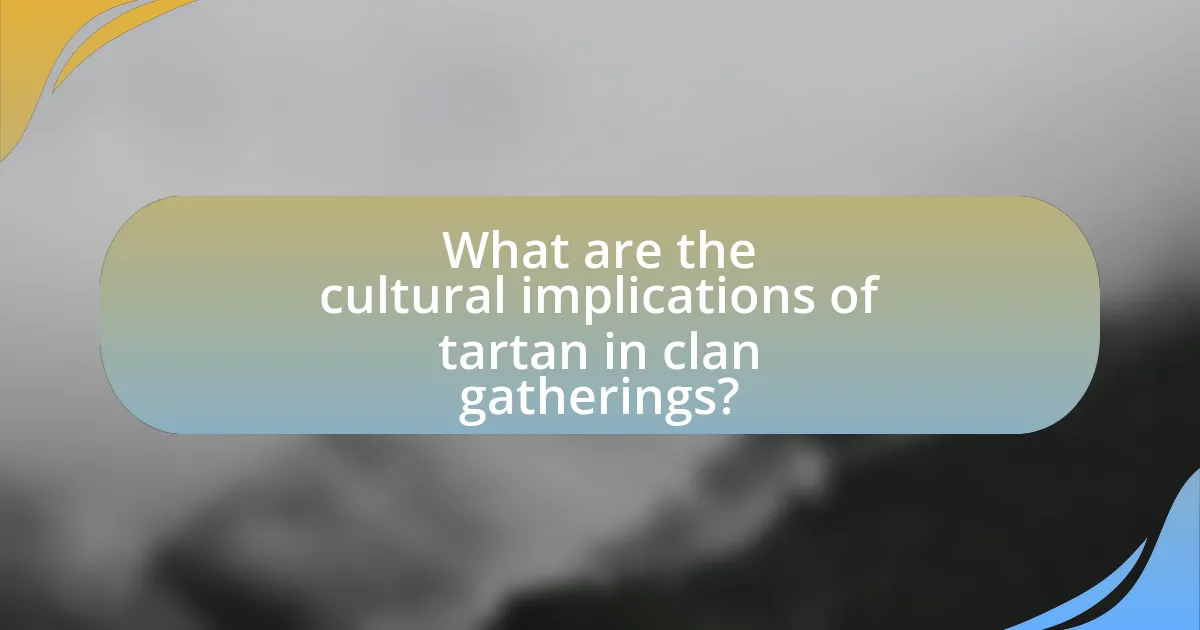
What are the cultural implications of tartan in clan gatherings?
Tartan serves as a significant cultural symbol in clan gatherings, representing heritage, identity, and unity among clan members. The distinct patterns of tartan are often associated with specific clans, allowing individuals to express their lineage and foster a sense of belonging during communal events. Historically, tartan was used to signify clan allegiance, with different patterns denoting various clans, which reinforced social structures and kinship ties. The wearing of tartan at gatherings not only honors ancestral traditions but also strengthens communal bonds, as members come together to celebrate their shared history and cultural practices.
How does tartan foster a sense of community among clan members?
Tartan fosters a sense of community among clan members by serving as a visual symbol of shared heritage and identity. The distinct patterns and colors of tartan are often associated with specific clans, creating a sense of belonging and unity during gatherings and festivals. Historical evidence shows that clans used tartan to signify their allegiance and kinship, reinforcing social bonds. For instance, the wearing of clan tartan at events like the Highland Games not only celebrates cultural traditions but also strengthens connections among members, as they collectively identify with their clan’s unique pattern. This shared representation cultivates pride and solidarity, essential elements in fostering community among clan members.
What activities promote bonding through the use of tartan?
Activities that promote bonding through the use of tartan include clan gatherings, traditional games, and crafting workshops. Clan gatherings often feature participants wearing tartan, fostering a sense of unity and shared heritage among members. Traditional games, such as tug-of-war or caber tossing, often incorporate tartan elements, enhancing camaraderie through teamwork and friendly competition. Additionally, crafting workshops where individuals create or personalize tartan items, such as scarves or blankets, encourage collaboration and storytelling, further strengthening bonds within the community. These activities not only celebrate cultural identity but also create lasting connections among participants.
How do clan gatherings reinforce cultural traditions through tartan?
Clan gatherings reinforce cultural traditions through tartan by serving as a visual representation of clan identity and heritage. Tartan patterns are unique to specific clans, symbolizing lineage and belonging, which fosters a sense of community among members. During these gatherings, participants don their clan tartans, which not only honors their ancestry but also strengthens social bonds and collective memory. Historical evidence shows that tartan has been used since the 16th century to signify clan allegiance, making it a powerful tool for cultural continuity. The display of tartan at clan events thus acts as a reminder of shared history and values, reinforcing the cultural traditions that define the clan.
What challenges do clans face regarding tartan representation today?
Clans face significant challenges regarding tartan representation today, primarily due to issues of authenticity and commercialization. Many clans struggle to maintain the historical accuracy of their tartans as various companies produce and sell tartans that may not reflect the clan’s true heritage. This commercialization often leads to confusion among clan members and the public about which tartans are legitimate. Additionally, the proliferation of unofficial tartans can dilute the cultural significance of traditional patterns, making it difficult for clans to assert their identity and heritage in a meaningful way. The Scottish Register of Tartans, established to preserve and authenticate tartan designs, highlights the importance of accurate representation, yet enforcement remains a challenge in the face of widespread unauthorized production.
How do modern interpretations of tartan affect traditional practices?
Modern interpretations of tartan significantly influence traditional practices by introducing new designs and uses that often diverge from historical patterns. These contemporary adaptations can lead to a dilution of the original meanings associated with specific tartans, as many modern variations prioritize aesthetic appeal over cultural significance. For instance, the introduction of non-traditional colors and patterns in commercial products can overshadow the traditional clan identities that tartans historically represented, as evidenced by the proliferation of “fashion tartans” that lack historical context. This shift can create confusion regarding clan heritage during clan gatherings and festivals, where authenticity is often celebrated.
What efforts are being made to preserve the significance of tartan in clan culture?
Efforts to preserve the significance of tartan in clan culture include the establishment of organizations dedicated to promoting and educating about tartan heritage, such as the Scottish Tartans Authority. These organizations work to document tartan patterns, provide resources for clans to create and maintain their unique tartans, and organize events that celebrate tartan’s cultural importance. Additionally, educational programs in schools and community events raise awareness about the historical and social significance of tartan, ensuring that future generations understand its role in clan identity and heritage.
What are some best practices for participating in clan gatherings with tartan?
To participate effectively in clan gatherings with tartan, individuals should wear their clan’s specific tartan pattern to honor their heritage. Wearing the correct tartan signifies respect for clan traditions and fosters a sense of belonging among members. Additionally, participants should engage in clan activities, such as traditional dances and games, which often highlight the cultural significance of tartan. Understanding the history and meaning behind the tartan can enhance participation, as it allows individuals to share stories and connect with others. Lastly, being respectful of clan customs and protocols during gatherings is essential, as it demonstrates appreciation for the collective identity represented by the tartan.
How can individuals ensure they are wearing the correct tartan for their clan?
Individuals can ensure they are wearing the correct tartan for their clan by researching their specific clan’s tartan patterns, which are often documented in clan registries or tartan databases. Each Scottish clan has designated tartans that represent its heritage, and these can be verified through resources such as the Scottish Register of Tartans, which provides official records of tartan designs associated with clans. Additionally, consulting with clan societies or organizations can provide guidance on the appropriate tartan to wear, as they often have detailed information about clan history and associated tartans.
What etiquette should be observed when wearing tartan at clan events?
When wearing tartan at clan events, individuals should adhere to the specific tartan associated with their clan, as this demonstrates respect for heritage and identity. It is important to wear the tartan in a manner that is appropriate for the occasion, which typically includes formal attire such as kilts or sashes for men and women, respectively. Additionally, individuals should avoid mixing different clan tartans, as this can be seen as disrespectful to the clan’s traditions. Historical context supports this etiquette, as clan tartans have been used for centuries to signify allegiance and unity within Scottish culture.
